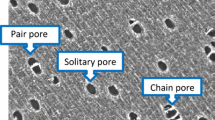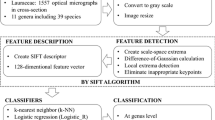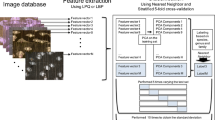Abstract
Advances in species recognition technologies can contribute to the conservation and protection of flora species, especially those threatened with extinction. The aim of this research was to compare the early fusion approaches of operators known as Local Binary Patterns (LBP) and late fusion, carried out at the level of the decision classifiers, in the construction of an automatic recognition system of forest species. 1901 macroscopic images of wood from 46 Brazilian species were used. The extraction of image characteristics was done using two variants of the LBP descriptor, covering different aspects of spatial and angular resolution. The repeated stratified k-fold cross-validation method was used to estimate the performance of the classifiers. The cross-validation folds were created using stratified random sampling, whose strata were the prediction classes. An automatic recognition system based on the concatenation of rotation-invariant LBP histograms and the SVM classifier showed an F1-score of 97.67%. The fusion of classifiers, through majority voting, improved the F1-score of this system by 0.33% point. This experiment revealed that more than 50% of the species showed no misclassification or occurred only once or twice. It was identified that some groups of species generally confused by wood anatomists were perfectly differentiated by this classification system. The recognition system showed good ability to identify species, and if this technology is combined with traditional identification tools and empirical knowledge, it is possible to minimize errors in the identification of Brazilian flora, especially endangered species, for which the proposed classification system showed high accuracy.







Similar content being viewed by others
References
Ahonen T, Matas J, He C, Pietikäinen M (2009) Rotation invariant image description with local binary pattern histogram fourier features. In: Scandinavian Conference on Image Analysis, Springer Berlin Heidelberg, pp 61–70, https://doi.org/10.1007/978-3-642-02230-2_7
Berti RN, Abbate ME (1992) Legnami tropicali importati in italia: Anatomia e identificazione (Tropical timber imported into Italy: Anatomy and identification). volume ii: Latin america
Bhikhi CR, Maas PJM, Koek-Noorman J, van Andel TR (2016) Timber Trees of Suriname. LM Publishers, Volendam, Países Baixos
Bila NF, Luis R, Gonçalves TAP, de Muñiz GIB, Nisgoski S (2018) Wood anatomy of five species from mozambique and its potential application. Bosque 39(2):169–175. https://doi.org/10.4067/s0717-92002018000200169
Carreras R, Cuza A, Teruel J, González LR (2012) Arboles y maderas de Baracoa, Cuba (Trees and woods from Baracoa, Cuba). Publicitat Tafanet, Spain
Costa MLM, Bajgielman T, Pereira TS, Maurenza D, Amaro R, Dalcin EC, Maunder M (2016) Estratégia nacional para a conservação ex situ de espécies ameaçadas da flora brasileira (National strategy for the ex situ conservation of endangered species of Brazilian flora). Centro Nacional de Conservação da Flora — CNC Flora: Jardim Botânico do Rio de Janeiro: Andrea Jakobsson, Rio de Janeiro. 24 p
Deklerck V, Mortier T, Goeders N, Cody RB, Waegeman W, Espinoza E, Acker JV, den Bulcke JV, Beeckman H (2019) A protocol for automated timber species identification using metabolome profiling. Wood Sci Technol 53(4):953–965. https://doi.org/10.1007/s00226-019-01111-1
Détienne P, Jacquet P (1983) Atlas d’identification des bois de l’Amazonie et des régions voisines (Identification Atlas of the woods of the Amazon and neighboring regions). GERDAT-CTFT
Fedalto LC, Mendes I, Coradin VTR (1989) Madeiras da Amazônia, descrição do lenho de 40 espécies ocorrentes na Floresta Nacional do Tapajós (Timber from the Amazon, description of the wood of 40 species occurring in the Tapajós National Forest). Tech. rep, Brazilian Institute of the Environment and Renewable Natural Resources
Figueroa-Mata G, Mata-Montero E, Valverde-Otarola JC, Arias-Aguilar D (2018) Using deep convolutional networks for species identification of xylotheque samples. In: 2018 IEEE International Work Conference on Bioinspired Intelligence (IWOBI), IEEE, https://doi.org/10.1109/iwobi.2018.8464216
Forzza RC, Leitman PM, Costa A, Carvalho Jr AAd, Peixoto AL, Walter BMT, Bicudo C, Zappi D, Costa DPd, Lleras E, et al. (2010) Catálogo de plantas e fungos do Brasil-Vol. 1 (Catalog of plants and fungi from Brazil-Vol. 1). JBRJ
Hafemann LG, Oliveira LS, Cavalin P (2014) Forest species recognition using deep convolutional neural networks. In: 2014 22nd International Conference on Pattern Recognition, IEEE, https://doi.org/10.1109/icpr.2014.199
He DC, Wang L (1990) Texture unit, texture spectrum, and texture analysis. IEEE Trans Geosci Remote Sens 28(4):509–512. https://doi.org/10.1109/igarss.1989.575836
IBÁ (2016) Relatório anual ibá 2016 (Ibá 2016 annual report)
Ibrahim I, Khairuddin ASM, Talip MSA, Arof H, Yusof R (2016) Tree species recognition system based on macroscopic image analysis. Wood Sci Technol 51(2):431–444. https://doi.org/10.1007/s00226-016-0859-4
Karatzoglou A, Smola A, Hornik K, Zeileis A (2004) kernlab-an s4 package for kernel methods in r. J Stat Softw 11(9):1–20. https://doi.org/10.18637/jss.v011.i09
Khalid M, Lee ELY, Yusof R, Nadaraj M (2008) Design of an intelligent wood species recognition system. Int J Simul Syst Sci Technol 9(3):9–19
Kobayashi K, Hwang SW, Lee WH, Sugiyama J (2017) Texture analysis of stereograms of diffuse-porous hardwood: identification of wood species used in tripitaka koreana. J Wood Sci 63(4):322–330. https://doi.org/10.1007/s10086-017-1625-4
Kobayashi K, Hwang SW, Okochi T, Lee WH, Sugiyama J (2019) Non-destructive method for wood identification using conventional x-ray computed tomography data. J Cult Herit 38:88–93. https://doi.org/10.1016/j.culher.2019.02.001
Kribs DA (1968) Commercial foreign woods on the American market. Dover Publications, New York
Kuhn M, Johnson K (2013) Applied predictive modeling, vol 810. Springer, New York
Kuhn M, Wing J, Weston S, Williams A, Keefer C, Engelhardt A, Cooper T, Mayer Z, Kenkel B, Team R, et al. (2016) CARET: Classification and regression training. In: R package version 6.0–21. CRAN, Vienna, Austria
Kuo TY, Wang WC (2019) Determination of elastic properties of latewood and earlywood by digital image analysis technique. Wood Sci Technol 53(3):559–577. https://doi.org/10.1007/s00226-019-01096-x
Lens F, Baas P, Jansen S, Smets E (2007) A search for phylogenetically informative wood characters within lecythidaceae s.l. Am J Bot 94(4):483–502. https://doi.org/10.3732/ajb.94.4.483
Liaw A, Wiener M, et al. (2002) Classification and regression by randomforest. R news 2(3):18–22, Accessed: 2019-09-17 01:53:28
Liu L, Fieguth P, Guo Y, Wang X, Pietikäinen M (2017) Local binary features for texture classification: taxonomy and experimental study. Pattern Recognit 62:135–160. https://doi.org/10.1016/j.patcog.2016.08.032
Mainieri C (1958) I-Madeiras Denominadas Caixeta (I-Woods Named Caixeta Brazil). Instituto de Pesquisas Tecnológicas, São Paulo, Brazil. Publicação no. 572
Marchiori JNC (1995) Anatomia da madeira e casca da bracatinga, mimosa scabrella benth. Anatomy of wood and bark of bracatinga, mimosa scabrella benth). Sci Nat 17(17):115. https://doi.org/10.5902/2179460x26536
Martinelli G, Moraes MA (2013) Livro vermelho da flora do Brasil (Red book on the flora of Brazil). CNCFlora, National Center for Flora Conservation Rio de Janeiro
Martins J, Oliveira L, Nisgoski S, Sabourin R (2013) A database for automatic classification of forest species. Mach Vis Appl 24(3):567–578. https://doi.org/10.1007/s00138-012-0417-5
Martins J, Oliveira LS, Britto A, Sabourin R (2015) Forest species recognition based on dynamic classifier selection and dissimilarity feature vector representation. Mach Vis Appl 26(2–3):279–293. https://doi.org/10.1007/s00138-015-0659-0
Maruyama T, Oliveira L, Britto A Jr, Nisgoski S (2018) Automatic classification of native wood charcoal. Ecol Inform 46:1–7. https://doi.org/10.1016/j.ecoinf.2018.05.008
Miller RB, Détienne P (2001) Major timber trees of Guyana: wood anatomy. The Tropenbos Foundation, Wageningen, https://www.tropenbos.org/resources/publications
MMA (2014) Portaria MMA n. 443, de 17 de dezembro de 2014. Reconhece como espécies da flora brasileira ameaçadas de extinção aquelas constantes da lista nacional oficial de espécies da flora ameaçadas de extinção (Ordinance MMA no. 443, of december 17, 2014. Recognizes as species of Brazilian flora threatened with extinction those included in the official national list of species of flora threatened with extinction)
Molinaro AM, Simon R, Pfeiffer RM (2005) Prediction error estimation: a comparison of resampling methods. Bioinformatics 21(15):3301–3307. https://doi.org/10.1093/bioinformatics/bti499
Muñiz GIB, Nisgoski S, Shardosin FZ, França RF (2012) Anatomia do carvão de espécies florestais (Anatomy of forest species charcoal). CERNE 18(3):471–477. https://doi.org/10.1590/s0104-77602012000300015
Muñiz GIB, Carneiro ME, Batista R, Rodrigues F, Zatt Schardosin F, Nisgoski S (2016) Wood and charcoal identification of five species from the miscellaneous group known in brazil as “angelim” by near-ir and wood anatomy. Maderas Ciencia y tecnología 18(3):505–522. https://doi.org/10.4067/s0718-221x2016005000045
Nasirzadeh M, Khazael AA, bin Khalid M, (2010) Woods recognition system based on local binary pattern. 2010 2nd International Conference on Computational Intelligence. In: Communication Systems and Networks, IEEE, pp 308–313
Ojala T, Pietikainen M, Harwood D (1994) Performance evaluation of texture measures with classification based on kullback discrimination of distributions. In: Proceedings of 12th International Conference on Pattern Recognition, IEEE, vol 1, pp 582–585, https://doi.org/10.1109/icpr.1994.576366
Ojala T, Pietikäinen M, Mäenpää T (2002) Multiresolution gray-scale and rotation invariant texture classification with local binary patterns. IEEE Trans Pattern Anal Mach Intell 24(7):971–987. https://doi.org/10.1109/tpami.2002.1017623
Pace MR, Angyalossy V (2013) Wood anatomy and evolution: a case study in the bignoniaceae. Int J Plant Sci 174(7):1014–1048. https://doi.org/10.1086/670258
Paula Filho PL, Oliveira LS, Nisgoski S, Britto AS (2014) Forest species recognition using macroscopic images. Mach Vis Appl 25(4):1019–1031. https://doi.org/10.1007/s00138-014-0592-7
Pietikäinen M, Ojala T, Xu Z (2000) Rotation-invariant texture classification using feature distributions. Pattern Recognit 33(1):43–52. https://doi.org/10.1016/s0031-3203(99)00032-1
Procópio LC, Secco RdS (2008) A importância da identificação botânica nos inventários florestais: o exemplo do “tauari” (Couratari spp. e Cariniana spp.-lecythidaceae) em duas áreas manejadas no estado do Pará (The importance of botanical identification in forest inventories: the example of “tauari” (Couratari spp. and Cariniana spp. - lecythidaceae) in two areas managed in the state of Pará). Acta Amaz 38:31–44. https://doi.org/10.1590/S0044-59672008000100005
PROTA (2002) Protabase, Plant Resources of Tropical Africa/Ressources végétales de l’Afrique tropicale. Wageningen, Netherlands
Quirk JT (1980) Wood anatomy of the vochysiaceae. IAWA J 1(4):172–179. https://doi.org/10.1163/22941932-90000717
Ravindran P, Costa A, Soares R, Wiedenhoeft AC (2018) Classification of CITES-listed and other neotropical meliaceae wood images using convolutional neural networks. Plant Methods 14(1), https://doi.org/10.1186/s13007-018-0292-9
Refaeilzadeh P, Tang L, Liu H (2009) Cross validation, Encyclopedia of Database Systems (EDBS). Arizona State University, Springer, New York, pp 532–538
Richter H, Dallwitz M (2009) Commercial timbers: descriptions, illustrations, identification, and information retrieval. version: 25th june 2009
Siew KF, Tang XJ, Tay YH (2017) Improved convolutional networks in forest species identification task. In: Jiang X, Arai M, Chen G (eds) Second International Workshop on Pattern Recognition, SPIE, https://doi.org/10.1117/12.2280616
Soffiatti P, Boeger MRT, Nisgoski S, Kauai F (2016) Wood anatomical traits of the araucaria forest, southern Brazil. Bosque 37(1):21–31. https://doi.org/10.4067/s0717-92002016000100003
Tortorelli LA (1956) Maderas y bosques argentinos (Argentine woods and forests). Editorial Acme, Buenos Aires
Venables WN, Ripley BD (2002) Modern Applied Statistics with S, 4th edn. Springer, New York
Wheeler EA, Baas P, Gasson PE et al (1989) Iawa list of microscopic features for hardwood identification. IAWA Bulletin 10(3):
White L, Gasson P (2008) Mahogany. Kew Publishing, Royal Botanic Gardens
Yadav AR, Anand R, Dewal M, Gupta S (2015) Multiresolution local binary pattern variants based texture feature extraction techniques for efficient classification of microscopic images of hardwood species. Appl Soft Comput 32:101–112. https://doi.org/10.1016/j.asoc.2015.03.039
Yigit E, Sabanci K, Toktas A, Kayabasi A (2019) A study on visual features of leaves in plant identification using artificial intelligence techniques. Comput Electron Agric 156:369–377. https://doi.org/10.1016/j.compag.2018.11.036
Yusof R, Khalid M, Khairuddin ASM (2013) Application of kernel-genetic algorithm as nonlinear feature selection in tropical wood species recognition system. Comput Electron Agric 93:68–77. https://doi.org/10.1016/j.compag.2013.01.007
Acknowledgements
We thank the Laboratory of Anatomy and Wood Quality (LANAQM) of Federal University of Paraná (UFPR) for making data available. This study was financed in part by the Coordenação de Aperfeiçoamento de Pessoal de Nível Superior—Brazil (CAPES)—Finance Code 001 and by the Conselho Nacional de Desenvolvimento Científico e Tecnológico (CNPq).
Author information
Authors and Affiliations
Corresponding author
Ethics declarations
Conflict of interest
The authors declare that they have no known competing financial interests or personal relationships that could have appeared to influence the work reported in this paper.
Additional information
Publisher's Note
Springer Nature remains neutral with regard to jurisdictional claims in published maps and institutional affiliations.
Rights and permissions
About this article
Cite this article
Souza, D.V., Santos, J.X., Vieira, H.C. et al. An automatic recognition system of Brazilian flora species based on textural features of macroscopic images of wood. Wood Sci Technol 54, 1065–1090 (2020). https://doi.org/10.1007/s00226-020-01196-z
Received:
Published:
Issue Date:
DOI: https://doi.org/10.1007/s00226-020-01196-z




